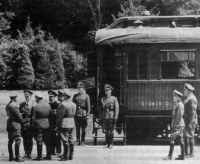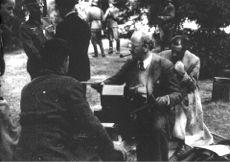
To order Hitler Sites ($55) click here
|
Hitler accepts the French surrender, June 21, 1940: Launch Real Player This option requires Real Player. Click here to download Real Player Launch Windows Media Player This option requires Microsoft's Windows Media Player. Click here to download Windows Media Player |
|
In June 1940, just after his armies had smashed France, Hitler
traveled to Compiègne. Here, in a forest clearing, on November 11, 1918, Marshal
Ferdinand Foch, the French commander, had humbled the Kaiser's generals and
accepted a humiliating German surrender, the armistice ending World War I. Foch
held the fateful meeting in his railroad car, number 2419D, a dining car that
the Wagon-Lits Company had converted to an office on wheels. The German
delegation arrived in another train.
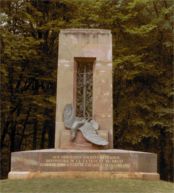 French officials later made the site into what they called the “Glade of the
Armistice.” The French architect M. Magès opened up a grand avenue, 250 yards
long, leading to a broad circular center with a great granite block inscribed:
“Here on 11th November 1918 perished the criminal pride of the German Empire
defeated by the free people whom it set out to enslave.” At the entrance to
Magès’ avenue stood an imposing monument in Alsatian sandstone, erected by the
newspaper Le Matin’s public subscription, depicting the point of a sword
impaling a large limp eagle. Underneath was inscribed: “To the heroic soldiers
of France...Defenders of the country and of right...Glorious liberators of
Alsace Lorraine.” A statue of Marshal Foch gazing out with imperious
satisfaction was added in September 1937.
French officials later made the site into what they called the “Glade of the
Armistice.” The French architect M. Magès opened up a grand avenue, 250 yards
long, leading to a broad circular center with a great granite block inscribed:
“Here on 11th November 1918 perished the criminal pride of the German Empire
defeated by the free people whom it set out to enslave.” At the entrance to
Magès’ avenue stood an imposing monument in Alsatian sandstone, erected by the
newspaper Le Matin’s public subscription, depicting the point of a sword
impaling a large limp eagle. Underneath was inscribed: “To the heroic soldiers
of France...Defenders of the country and of right...Glorious liberators of
Alsace Lorraine.” A statue of Marshal Foch gazing out with imperious
satisfaction was added in September 1937.
CBS Radio correspondent William L. Shirer arrived at Compiègne on June 19, 1940.
German army engineers with pneumatic drills were feverishly demolishing the wall
of the museum where Foch’s railroad car was kept. Finally, they hauled the car
out to the spot it occupied in November 1918.
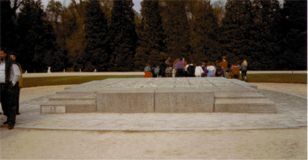 At three PM on June 21, Hitler walked past the Alsatian monument with its
skewered eagle, now bedecked with red Reich flags bearing black swastikas. He
wore a double-breasted gray uniform. His World War I Iron Cross First Class hung
from his left breast pocket; a Jewish officer, Lieutenant Hugo Gutmann, had
nominated him for this decoration. To Shirer, Hitler’s face looked grave,
solemn, brimming with revenge and scornful inner joy. The Führer’s step was
springy, the step of a triumphant conqueror who had defied the world.
At three PM on June 21, Hitler walked past the Alsatian monument with its
skewered eagle, now bedecked with red Reich flags bearing black swastikas. He
wore a double-breasted gray uniform. His World War I Iron Cross First Class hung
from his left breast pocket; a Jewish officer, Lieutenant Hugo Gutmann, had
nominated him for this decoration. To Shirer, Hitler’s face looked grave,
solemn, brimming with revenge and scornful inner joy. The Führer’s step was
springy, the step of a triumphant conqueror who had defied the world.
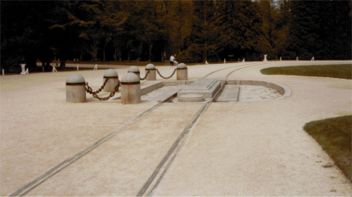 Surrounded by his entourage, Hitler strode up to the massive central granite
block and read its inscription in silence. As he stepped off the monument, he
glanced back at it, snide, angry. He swiftly snapped his hands on his hips,
arched his shoulders, and planted his feet wide apart, a haughty gesture of
defiance and burning contempt.
Surrounded by his entourage, Hitler strode up to the massive central granite
block and read its inscription in silence. As he stepped off the monument, he
glanced back at it, snide, angry. He swiftly snapped his hands on his hips,
arched his shoulders, and planted his feet wide apart, a haughty gesture of
defiance and burning contempt.
Hitler led his entourage to another smaller granite stone, fifty yards to one
side. This stone marked the position of the German generals’ railroad car on
November 11, 1918. Hitler gave only a passing glance at the inscription, “The
German Plenipotentiaries.” The stone itself lay between a pair of rusty railroad
tracks. Hitler appeared not even to see the nearby statue of Marshal Foch.
In Foch’s railroad car, Hitler gave the Nazi salute, arm raised. As his generals
handed armistice terms to the defeated, dispirited French, he sat at the same
table in the same position as Foch but said nothing. Twelve minutes after the
French arrived, Hitler stood up, saluted stiffly, and alighted from the car. The
whole surrender ceremony was over in fifteen minutes.
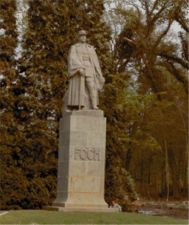 During the occupation (1940-44) the Germans laid waste to the entire site. They
dynamited the inscribed central granite block, plowed up the avenues, cut down
the trees, and took Foch’s railroad car to Berlin, where in 1944 it was
destroyed during a British air raid. Only Foch’s statue was left untouched. Why?
Hitler wanted the despised victor of 1918 to stand witness to the ruin of his
work.
During the occupation (1940-44) the Germans laid waste to the entire site. They
dynamited the inscribed central granite block, plowed up the avenues, cut down
the trees, and took Foch’s railroad car to Berlin, where in 1944 it was
destroyed during a British air raid. Only Foch’s statue was left untouched. Why?
Hitler wanted the despised victor of 1918 to stand witness to the ruin of his
work.
After the war, the French used German prisoners to completely restore the Glade
of the Armistice. Today, visitors can see a meticulous reproduction of Foch’s
railroad car in a shed where the original had been kept.
![]()
|
CBS News' William L Shirer reports the French surrender, June 21, 1940: Launch Real Player Launch Windows Media Player |
|
![]()
|
Edward R. Murrow describes the fall of France and the
appointment of Winston Churchill as Prime Minister of Great Britain: Launch Real Player Launch Windows Media Player |
|
| Achtung! Hier ist der Großdeutsche Rundfunk. Sie hören jetzt die soeben angetroffenen ersten Rundfunkberichte vom Beginn der Verhandlungen über den Waffenstillstand mit Frankreich im Walde von Compiègne. |
German shortwave radio announcer: Attention! This is the Great German Radio. You will now hear the first arriving radio reports on the beginning of the armistice negotiations with France in Compiègne forest. |
To order Hitler Sites ($55) click here


